China Sea Freight Transport Market Size
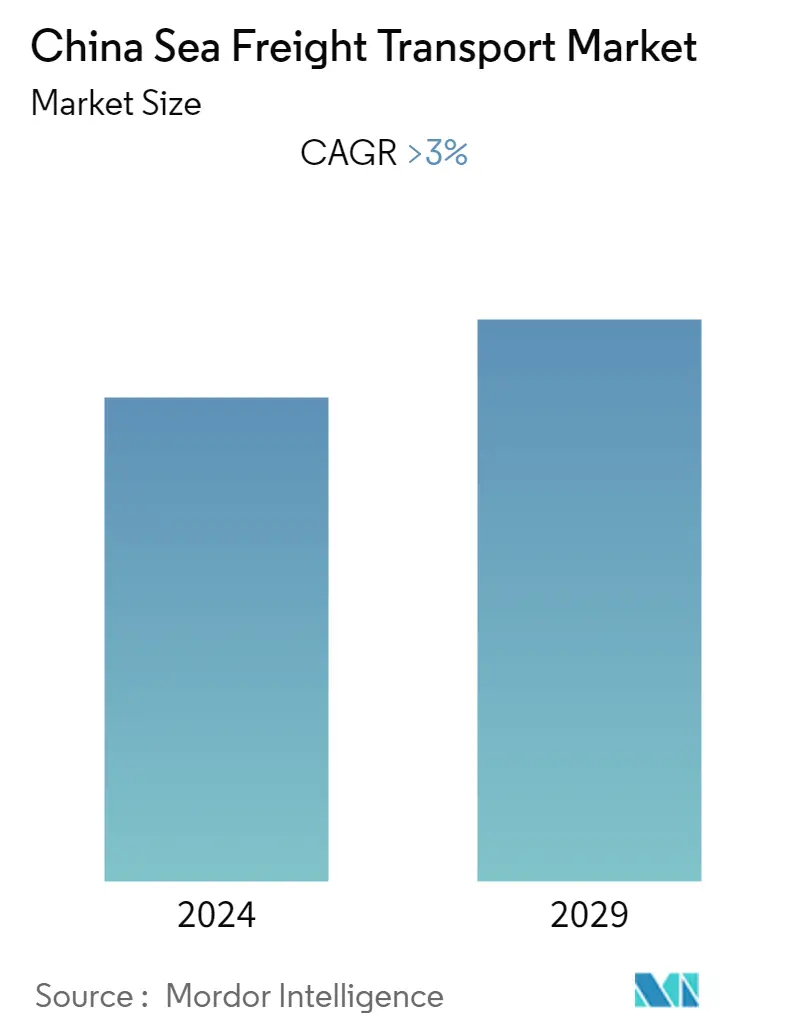
| Study Period | 2020 - 2029 |
| Base Year For Estimation | 2023 |
| Forecast Data Period | 2024 - 2029 |
| Historical Data Period | 2020 - 2022 |
| CAGR | 3.00 % |
| Market Concentration | Low |
Major Players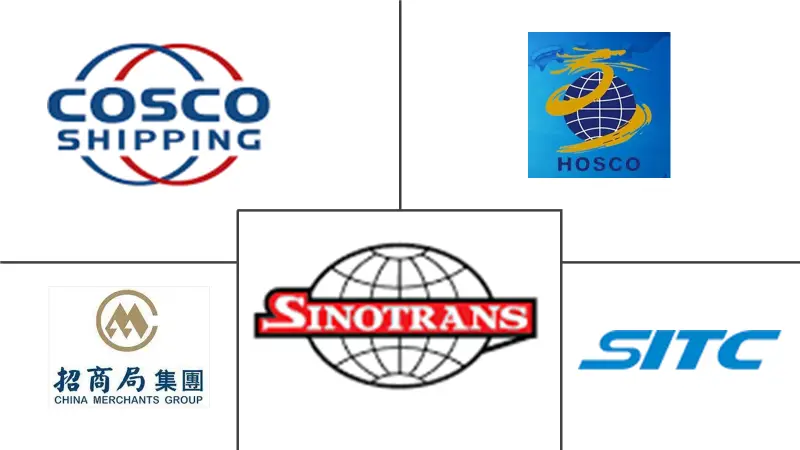
*Disclaimer: Major Players sorted in no particular order |
China Sea Freight Transport Market Analysis
The maritime industry in China is expected to grow at a CAGR of more than 3% during the forecast period. China imports and exports goods to nearly every country on the planet. Foreign trade makes a significant contribution to the country's GDP. Chinese commodities are in high demand all around the world (either finished goods or raw materials). China has become the world's only major economy to post positive GDP growth in 2020. Despite a 6.8% decrease in the quarter ending March 2020, when China was coping with a spike in Covid-19 cases, the annual growth rate for 2020 has been raised to 2.3 percent. As a result of the Covid-19 pandemic, China's foreign trade has endured severe shortages, container rejections, port congestion, exports down 54.1 percent, imports down 49.6 percent, and sky-high freight prices.
China's cargo exports and imports primarily rely on two modes of transportation: sea and land, with the China-Europe express train serving as the primary mode of land transportation. As a result, the shipping channel has been contracted to more than 85% of the total volume of commodities exported and imported.Sea freight transport is critical to China's trade-oriented economy, and it has played a significant part in the country's development. The following are the major growth drivers in the Chinese sea freight transportation industry: Because of its overall competitiveness, China is gaining market share from other Asian countries through organic growth. The industry's main powerhouse is China's incredible rate of economic expansion. The containerization of bulk freight.
Due to the covid-19 epidemic in 2020, manufacturing has halted, trade volumes in numerous countries have fallen, and the shipping market's expansion has been significantly affected. In a very short amount of time, the internal epidemic was effectively handled, the economy gradually recovered, industrial production quickly rebounded, domestic products were provided to the global market, and demand for export trade rose. The cargo throughput of Chinese ports reached 13.25 billion tonnes from January to November 2020, an increase of 4.18 percent over the same period in 2019. The container growth rate of major global ports has remained negative in the first three quarters of 2020, while the container throughput of Ningbo Zhoushan Port, Guangzhou Port, Qingdao Port, and Tianjin Port has maintained positive growth trends to varying degrees, indicating that the domestic market is recovering.
China Sea Freight Transport Market Trends
This section covers the major market trends shaping the China Sea Freight Transport Market according to our research experts:
Positive Trend of Chinese Imports and Exports.
For Chinese export and import businesses, sea freight transport is the most common mode of transit. China's exports increased by 1.5 percent to USD 4.65 trillion in 2020, owing to improved manufacturing output. Exports totaled USD 2.59 trillion, up 3.6 percent, while imports totaled USD 2.06 trillion, down 1.1 percent. China's 1.1 percentage point gain in its proportion of global GDP in 2020 is the highest in a single year since the 1970s. In 2020, trade between the world's two largest economies, China and the United States were back on track. China's exports to United States increased by 7.9% to USD 451.81 billion in 2020, while imports from United States increased by 9.8% to USD 134.91 billion. After the Association of Southeast Asian Nations (ASEAN) and European Union, United States was China's third-largest trading partner in 2020. In 2020, imports and exports to European Union increased by 5.3 percent. Chinese agricultural imports from the United States increased by 66.9% in 2020, with soybean imports up 56.3 percent and pork imports up 223.8 percent. China's exports to United States fell 12.5 percent year on year to USD 418.5 billion in 2019, while its imports fell 20.9 percent to USD 122.7 billion. Although United States administration has continued to disrupt bilateral ties over the past year 2019 through sanctions and export regulations, the COVID-19 epidemic, which has given a significant blow to United States economy, is seen as fuelling its demand for Chinese products, particularly medical and stay-at-home products.
The updated China-ASEAN Free Trade Agreement was signed with the signing of the Regional Comprehensive Economic Partnership (RCEP). According to Chinese customs statistics, trade between China and ASEAN reached 4.74 trillion yuan (USD 722.8 billion) in 2020, an increase of 7%. ASEAN and China are each other's most important trading partners. China has been the Philippines' most important trading partner, both as a source of exports and as a source of imports. China was the country's second-largest investment partner in 2020, especially in infrastructure and manufacturing. China surpassed United States as the European Union's main commercial partner in 2020. Imports from China to the European Union increased by 5.6 percent to EUR 383.5 billion (USD 463 billion) in 2020, while exports increased by 2.2 percent to EUR 202.5 billion.
ASEAN, European Union, United States, Japan, and South Korea are China's top five trading partners, with imports and exports of 4.74 trillion yuan, 4.5 trillion yuan, 4.06 trillion yuan, 2.2 trillion yuan, and 1.97 trillion yuan, respectively, up 7%, 5.3 percent, 8.8%, 1.2 percent, and 0.7 percent.
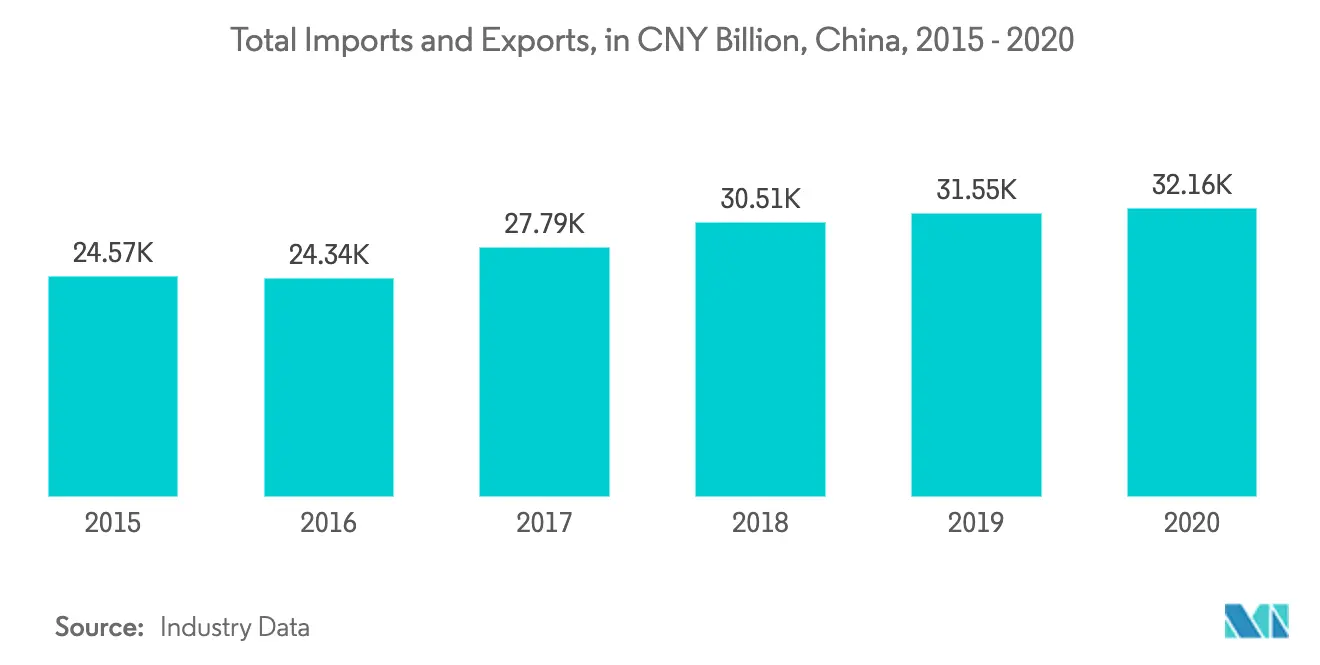
Demand of Chinese Goods in E-Commerce across the Globe:
In a pandemic-fuelled 2020, consumers spent nearly USD 4.29 trillion online, up from nearly USD 3.46 trillion in the year 2019. Global web sales increased by 24.1 percent in 2020, compared to 17.9 percent in 2019. China's cross-border e-commerce imports and exports totaled CNY 1.69 trillion (USD 261.5 billion) in 2020, up 31.1 percent. E-commerce exports increased by 40.1 percent to CNY 1.12 trillion, while imports increased by 16.5 percent to CNY 570 billion.
In China, cross-border e-commerce (CBEC) has become a more important route for import and export. China's CBEC exports have increased from 2.2 percent to 11.25 percent of the country's overall overseas commerce in the last six years. The government is encouraging CBEC development by increasing the country's international shipping capacity in 2020, as well as creating additional CBEC pilot zones and pilot towns, 50 cities were added to the existing 36 pilot cities for CBEC. China's import and export industries will benefit from the CBEC pilot zones (especially export). China is looking for chances to export products with higher value and margins as it invests heavily in improving its manufacturing facilities. For the first time in 2019, the value of Chinese cross-border B2C e-commerce exports exceeded the value of imports in 2019.
China was ranked as one of the top three most popular vendor countries in 2019 according to a cross-border e-commerce shopping study. Unlike Chinese buyers who seek high-quality goods from outside, European buyers are drawn to these platforms because of the low cost of Chinese items. On this year's Singles' Day (2020), two European countries, Spain and France, were among the top 10 destinations for Chinese exports.
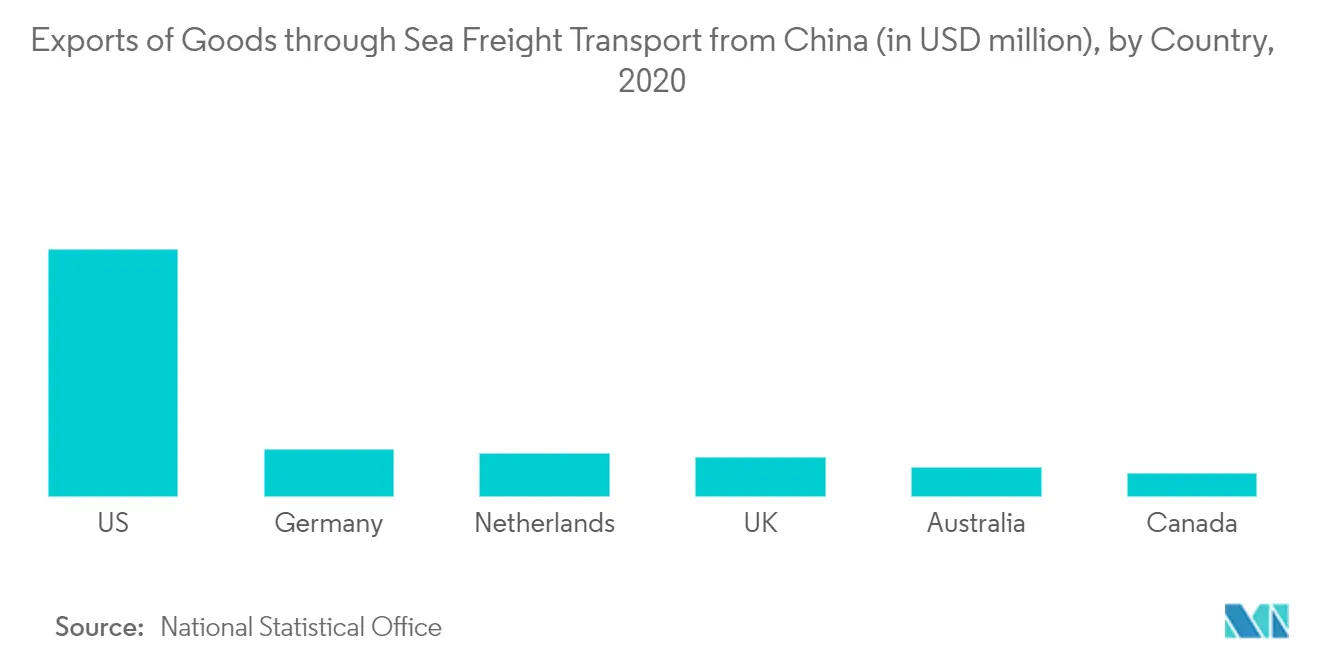
China Sea Freight Transport Industry Overview
The maritime industry in China is fragmented in nature with a mix of global and local players, this makes the sector highly competitive. Some of the strong players of the country include COSCO Shipping Lines, Sinotrans Limited, China Merchants Group, Hosco Group, and Nanjing Ocean Transport amongst others. As a result of the spread of covid-19, the majority of countries around the world have prohibited imports from China, which had a significant impact on the country's trade. After the restrictions have been lifted companies started to resume their operations and trade volumes also increased. The share of Chinese ships owned by Chinese carriers is less than one-tenth of the international shipping carriers that provide marine services for China's foreign trade in goods, with 90 percent of the cargo carried by foreign-registered ships.
China Sea Freight Transport Market Leaders
-
COSCO Shipping Lines
-
SINOTRANS Limited
-
Hebei Ocean Shipping (HOSCO)
-
China Merchants Group
-
SITC International Holdings Company Limited
*Disclaimer: Major Players sorted in no particular order
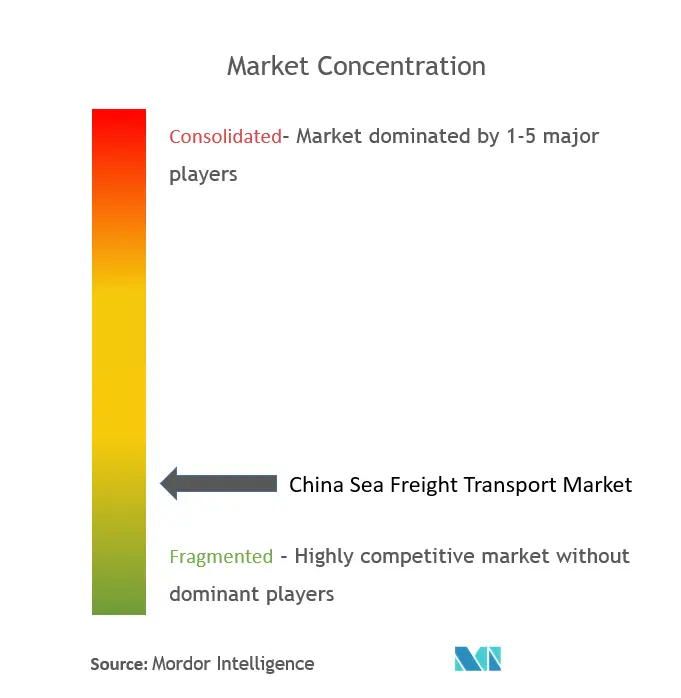
China Sea Freight Transport Market News
Feb 2021: COSCO Shipping Development purchased all of COSCO SHIPPING Investment's equity in four wholly-owned companies. The related businesses are primarily involved in the production of dry, special, and refrigerated containers, as well as the provision of container manufacturing technologies and R&D services.
Nov 2020: Vale, the world's largest producer of iron ore and nickel, has inked an investment agreement with Ningbo Zhoushan Port Company, the world's busiest port in terms of cargo tonnage. According to media sources, the Brazilian iron ore producer will form a joint venture with Ningbo Zhoushan Port, with each party spend 50% on the company's formation and operation. The company will be based in Shulanghu, Zhoushan, Ningbo, Zhejiang Province, East China.
China Sea Freight Transport Market Report - Table of Contents
1. Introduction
- 1.1 Study Assumptions and Market Definitions
- 1.2 Scope of the Study
2. Research Methodology
- 2.1 Analysis Methodology
- 2.2 Research Phases
3. Executive Summary
4. Market Insights
- 4.1 Current Market Scenario
- 4.2 Insights of Transshipment Trade
- 4.3 Insights on Containerized and Non-Containerized Shipments
- 4.4 Insights on Bunkering Services
- 4.5 Insights on Investments in Sea Freight Industry
- 4.6 Insights on Number of Establishments and Contribution of Sea Freight Sector to Total Services Sector
- 4.7 Government Regulations and Initiatives
- 4.8 Technological Trends and Automation in Ports
- 4.9 Impact of COVID -19 on the market
5. Market Dynamics
- 5.1 Market Drivers
- 5.2 Market Restraints/Challenges
- 5.3 Market Opportunities
-
5.4 Industry Attractiveness - Porter's Five Forces Analysis
- 5.4.1 Bargaining Power of Buyers/Consumers
- 5.4.2 Bargaining Power of Suppliers
- 5.4.3 Threat of New Entrants
- 5.4.4 Threat of Substitute Products
- 5.4.5 Intensity of Competitive Rivalry
6. Market Segmentation
- 6.1 Water Transport Services
- 6.2 Vessel Leasing and Rental Services
- 6.3 Cargo Handling (Container Services, Crane Services, Stevedoring Services, etc)
- 6.4 Supporting Service Activities to Water Transport (Shipping Agencies, Ship Brokering Services, Ship Management Services, etc)
7. Competitive Landscape
- 7.1 Market Concentration Overview
-
7.2 Company Profiles
- 7.2.1 COSCO Shipping Lines
- 7.2.2 SINOTRANS Limited
- 7.2.3 China Merchants Group
- 7.2.4 Hosco Group (Hebei Shipping)
- 7.2.5 SITC International Holdings Company Limited
- 7.2.6 CTS China Hong Kong International Logistics Co., Ltd.
- 7.2.7 Nanjing Ocean Shipping Co. Ltd.
- 7.2.8 C&K Ocean Shipping Company
- 7.2.9 Fujian Xiamen Shipping Co., Ltd.
- 7.2.10 Jincheng International Shipping Agency*
- *List Not Exhaustive
8. Future of The Market
9. Appendix
** Subject To AvailablityChina Sea Freight Transport Industry Segmentation
Sea freight is a way of carrying large quantities of products using cargo ships; products are packed into containers, which are then loaded into a vessel and sailed to their destination. China Sea Freight Transport Market report is segmented by Water Transport Services, Vessel Leasing, and Rental Services, Cargo Handling (Container Services, Crane Services, Stevedoring Services, etc), Supporting Service Activities to Water Transport (Shipping Agencies, Ship Brokering Services, Ship Management Services, etc)). A comprehensive background analysis of the China Sea Freight Transport Market covering the current market trends, restraints, technological updates, and detailed information on various segments and competitive landscape of the industry. The impact of COVID-19 has also been incorporated and considered during the study.
China Sea Freight Transport Market Research FAQs
What is the current China Sea Freight Transport Market size?
The China Sea Freight Transport Market is projected to register a CAGR of greater than 3% during the forecast period (2024-2029)
Who are the key players in China Sea Freight Transport Market?
COSCO Shipping Lines, SINOTRANS Limited, Hebei Ocean Shipping (HOSCO), China Merchants Group and SITC International Holdings Company Limited are the major companies operating in the China Sea Freight Transport Market.
What years does this China Sea Freight Transport Market cover?
The report covers the China Sea Freight Transport Market historical market size for years: 2020, 2021, 2022 and 2023. The report also forecasts the China Sea Freight Transport Market size for years: 2024, 2025, 2026, 2027, 2028 and 2029.
China Sea Freight Transport Industry Report
Statistics for the 2024 China Sea Freight Transport market share, size and revenue growth rate, created by Mordor Intelligence™ Industry Reports. China Sea Freight Transport analysis includes a market forecast outlook to 2029 and historical overview. Get a sample of this industry analysis as a free report PDF download.



